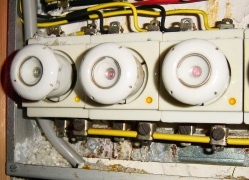Categories: Sharing experience, Electrician at home
Number of views: 46874
Comments on the article: 2
How to make the cable entry into the building
 It should be noted right away that all wiring to the meter is under the strict control of Energonadzor. This suggests that, say, the owner of the house will not mount this part of the wiring himself, except as an exception, at the appropriate stage of construction, if the owner knows how to connect the input cable (wire) to the input breaker inside the house.
It should be noted right away that all wiring to the meter is under the strict control of Energonadzor. This suggests that, say, the owner of the house will not mount this part of the wiring himself, except as an exception, at the appropriate stage of construction, if the owner knows how to connect the input cable (wire) to the input breaker inside the house.
But connecting to power systems is definitely prohibited. At the same time, this information will help you have an idea:
1. How the employees you hire adhere to established rules;
2. What preparatory work will have to be done;
3. What materials, types of basic work will be required and, accordingly, how much will it cost.
The wire connecting the overhead line (OHL) to the house is called a branch. If the branch length is not more than 25 m, then the installation of additional supports is not required.
Provided that this does not interfere with the compliance with the requirements set forth below.
The execution of the branch is allowed by uninsulated wires, but it is recommended (so reliable) to use insulated wires.
With a 3-phase branch, you can use a four-wire cable, where each core is insulated and a supporting cable is woven between them. Since the cable takes over the main load (weight), the cross section of the main cores, based on your needs, can be reduced to 4 sq. Mm.
The number of insulators installed on the wall is equal to the number of wires supplied: single-phase input -2; three-phase-4.
An additional insulator is used for the supporting cable, and this cable must be connected to the neutral wire.
The insulators themselves are fixed on hooks (in the everyday life “horns.”) Because of the serious load, it is most reliable to fasten the hooks to the studs. A through hole in the wall is drilled, a metal plate is welded onto the stud from the inside of the wall so that the stud does not slip out. From the outside - a metal strip with holes to fix it to a stud under the nut.
Hooks are welded to the plate itself. There is a branch connection without the use of insulators.
The lead-in cable and insulated branch wires are connected by insulated clamps.
What else is worth considering.
1. The distance from the wires, insulators to the surface of the earth is at least 2.75 m.
2. Above the pedestrian walkway - at least 3.5 m.
3. Above the carriageway - at least 6 m.
4. Above the site, the overhead line should run at a height of at least 5 m and away from tall trees — no closer than 3 m from the branches.
5. Between the wires themselves - at least 0.2 m.
6. From wires to the protruding parts of the house (gutter, roof) - - at least 0.2 m.
7. The horizontal distance between the wires of the overhead line and other cables (television, radio, telephone) should be at least 1.5 m.
The branch, if necessary, can be performed in the ground. The cable (!) Descends along the support. From a height of 1.5 m from the surface of the earth to a depth of 0.7 m is a protective pipe.
At the same depth - 0.7 m - in the trench to the building.
The rise is again in the pipe to the outer wall. Under the cable and above it in the trench, a layer of land without stones and construction debris is mandatory. Concrete tiles, bricks are laid over a layer of backfill in places of possible earthworks (it’s calmer), but they are mainly limited by a signal tape (bright red color with the inscription "Caution, cable!")
Vladimir Reprintsev
See also at e.imadeself.com
:
